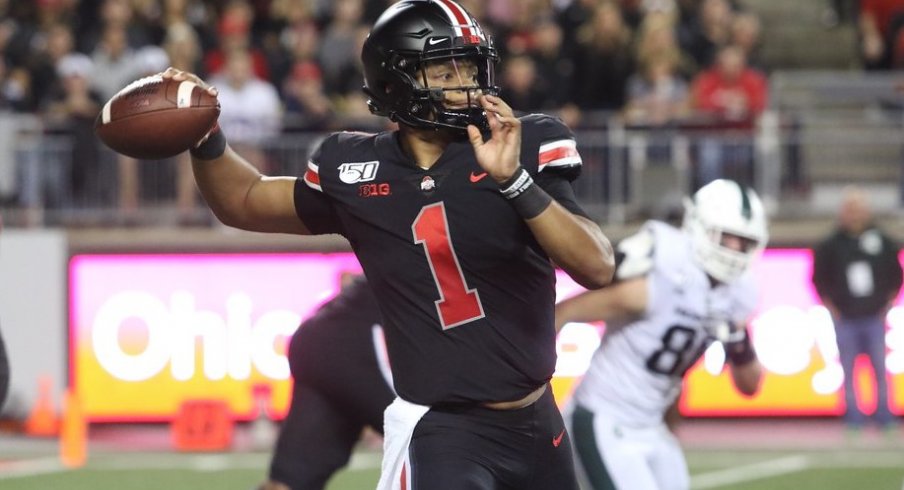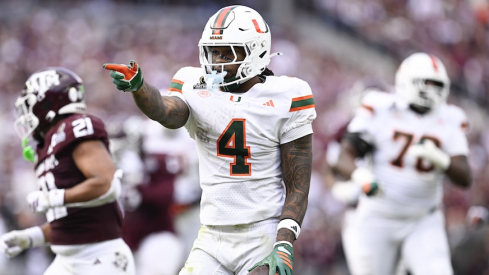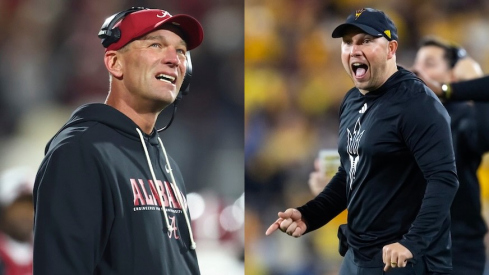"Justin was much more of an unknown because he had just got here in January. And so he's growing every day. He knows what he needs to work on." - Ryan Day
As Ohio State's offense continues to hum at a historic pace, averaging 7.31 yards-per-play and showing an ability to beat opponents both through the air and on the ground, Ryan Day's comments may feel somewhat disingenuous. Of course, the star quarterback is going to try and improve during the bye week because that's what players are supposed to do, but hasn't the sophomore from Georgia been a revelation? How else can he improve?
Though he's hardly thrown the ball as often, Fields has matched his predecessor, Dwayne Haskins, in non-volume stat categories through six games. The two are nearly identical in completion percentage (Fields: 69.5%, Haskins: 70.0%) and yards-per-attempt (Fields: 9.2, Haskins: 9.1), while Fields holds an edge QB rating in (187.54 to 174.08).
While equaling the passing prowess of perhaps the greatest player to ever grace the position in school history, Fields has the added advantage of running the ball as well, tallying 8 touchdowns and adding nearly 50-yards-per-game on the ground.
When asked to compare the two players during his team's bye week, Day remarked:
[Haskins] is kind of more of a pocket guy whose a little bit longer, leaner, 6'5". Maybe a little bit quicker release. [Fields] is 6'3", thicker, stronger in the pocket. Guys can kind of bounce off of him in there. He's a little stronger in there, can stand in there a little more, can create and extend plays. He's got a very strong arm, and that thing comes out with pace when it comes out.
I think Justin can make a throw anywhere on the field, at any point whether it's in the pocket or when he goes to escape. There's not really an area of the field he can't get the ball to. And a lot of times it's not even with his feet under him. He can get away with some of that stuff.
That ability to extend plays has been his trademark through the first half of the 2019 campaign, as Fields seems to turn a handful of what should be negative plays into big gains, thanks to his size, strength, and raw athleticism.
Just a sophomore, his ability to not only escape pressure but to keep his eyes downfield is a rare trait that can't be taught. But this isn't the only reason why the passing game hasn't lost a beat since he took over for a first-round talent like Haskins. If there is one area in which it appears can improve, however, it's with his seeming desire to hold onto the ball too long in the pocket and take sacks.
On one hand, it's a good thing that he's taking care of the ball instead of forcing it into windows that aren't open. He's thrown only one interception on 141 attempts this season and admitted to reporters after the game that he simply read one defender incorrectly, immediately recognizing his mistake.
But while Ohio State ranks 73rd nationally with 13 sacks-allowed through six games, not all are the fault of either the offensive line or the quarterback. They can sometimes simply be the price paid for being aggressive.
Moreso than ever before, Day has called for 2-receiver routes this season, leaving eight players in to block as Fields looks downfield on what are known as "shot" plays off run fakes.
They've been very successful at times, leading to long touchdown catches for Chris Olave and others. But when the defense is playing conservatively on the back end and doesn't bite on the play-action, there is nowhere for Fields to go with the ball.
While the deep throws may be what most fans see on SportsCenter recaps or College Gameday preview packages, the true engine for this passing game has been Fields' ability to hit his first read. Both from under center or in the shotgun, he comes to the top of his drop in the pocket and fires strikes to a receiver, often before they've even begun to break on a route.
As described by Chris B. Brown of SmartFootball.com, these are referred to as rhythm throws when included in a progression-based passing game:
"Progression Reads: A progression read is designed to have two, three, four, or five sequential choices of where to throw the ball. It is important for the quarterback to pre-read the coverage to get an indication of the coverage, but, more importantly, a progression read requires the quarterback to know where each of the receivers will be given the pattern called. This kind of read calls for throwing the ball with rhythm drops — i.e. on a five-step drop, the ball is thrown to the first receiver when the fifth step hits (the “rhythm” throw), the second receiver after a hitch-up or gather step (the “read” or “gather” throw), and the third receiver after resetting the feet."
Most modern passing games are progression based, at least in theory. However, coaches typically shrink them to only one side of the field, allowing the quarterback to only read the movement of just one defender. Given his NFL background, however, Day rarely utilizes half-field reads, asking his quarterbacks to work through as many as five routes across the width of the entire field.
This column could feature countless examples of Fields hitting his first read, or hitching once and driving the ball to the second. However, if there is one area in which he has been somewhat inconsistent, it's resetting his feet and finding the third read, which is often coming from the other side of the field in Day's offense.
In this example below, his first read appears to be a deep vertical route down the opposite sideline, which is taken away by the corner in soft coverage. Fields can see this as he's dropping back, leading him to work to the second read, which is a fake tunnel screen to the H receiver, allowing the tight end to feign a block before releasing downfield. Though one defender jumps the screen, there are three defenders sitting on the tight end's route, including the free safety in the middle of the field.
Though there is no immediate pressure, Fields doesn't reset his feet as he looks for the backside post, and instead looks to break the pocket. Though he throws the ball away and makes the safe play, he leaves a touchdown pass on the field as Binjimen Victor had inside position on the cornerback to the boundary.
Even when he finds the third read, Fields has shown a lack of confidence in getting the ball out at times.
As seen in this example, the first two reads, which are to the near sideline, are completely enveloped by the zone coverage. Fields properly resets his feet to the far sideline, and can clearly see the third read breaking open on a 12-yard curl behind the flat defender, who is chasing the H receiver on a shallow route outside.
Though that third read didn't appear to be open, Fields must utilize the same mentality he takes with rhythm throws on his first read, and identify the area into which the receiver will be running - the idea of "throwing the receiver open." With a full five-yard cushion between the receiver and the defender playing over the top, there is plenty of space for the QB to fire his pass into an open passing window. Luckily, the Buckeyes were in a position to kick a field goal on the next play but could have had a new set of downs instead.
To be clear, we're picking nits here. Few quarterbacks are able to successfully work back across the field and find their third read. Even fewer are sophomores who have started only a handful of games.
As such, we should point out that Fields is certainly capable of doing this very thing, even if it doesn't always work. With Nebraska's defense in a two-deep shell (below), the first two reads are smothered by two underneath defenders and a safety over the top.
But as that boundary safety jumps his second read, Fields recognizes that there won't be anyone to help defend the post coming behind it. Though there appear to be two defenders tracking that third read, one is a linebacker attempting to run with a wide receiver while the other is a backpedaling safety who has outside leverage.
With a clean pocket around him, Fields steps up to uncork a beautiful 50-yard toss that just misses the receiver by only a matter of inches. Such a pass can't be underthrown, the only way to miss is by throwing it too far - something few quarterbacks can do from such a distance.
That kind of arm strength makes the desire to progress through all his reads that much more important moving forward. Not all quarterbacks have the physical tools to make all the throws asked of them, especially in full-field progression systems.
Fields is not one of those quarterbacks, however.
"I think Justin can make a throw anywhere on the field, at any point whether it's in the pocket or when he goes to escape," Day told the media this past week. "There's not really an area of the field he can't get the ball to. And a lot of times it's not even with his feet under him. He can get away with some of that stuff. All the things that we're cleaning up in terms of technique and getting the ball out in time, but he's very talented."



